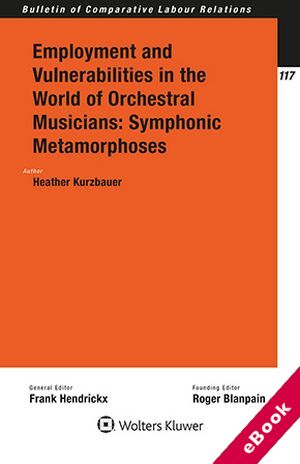
The device(s) you use to access the eBook content must be authorized with an Adobe ID before you download the product otherwise it will fail to register correctly.
For further information see https://www.wildy.com/ebook-formats
Once the order is confirmed an automated e-mail will be sent to you to allow you to download the eBook.
All eBooks are supplied firm sale and cannot be returned. If you believe there is a fault with your eBook then contact us on ebooks@wildy.com and we will help in resolving the issue. This does not affect your statutory rights.
Employment and Vulnerabilities in the World of Orchestral Musicians is a profoundly knowledgeable and provocative book penned by a versatile scholar who combines the roles of law professor, music journalist, and orchestral violinist. It presents the first major legal study to focus on labor relations and the institutional dynamics at play within orchestras. The state subsidies and philanthropy that traditionally allowed orchestras to flourish have greatly diminished due to recent financial crises and the COVID-19 pandemic. As in other fields affected by the precarious labor arrangements prevalent in the world of work today, the employees and freelancers—in this case, the musicians themselves—suffer the most. Based on personal interviews with more than 250 orchestral musicians and other stakeholders—whose testimonies and actions often stand in contradiction to narratives provided by cultural economists and government cultural policymakers—the author pays special attention to the deteriorating welfare of musicians in two countries, the United States and the Netherlands, in which she has considerable practical orchestral experience.
What’s in this book:
The methodology will strike a chord with musicians worldwide with its novel system of “movements” that focus on different vulnerabilities besetting orchestral players to highlight a number of topics including:
An interdisciplinary approach to vulnerabilities in the sector, the study incorporates economic, historical and legal research along with a consideration of sociological factors. Case studies—from the EU Court of Justice, the Dutch Supreme Court, the Supreme Court of the United States, and the U.S. National Labor Relations Board—offer practical insight into specific legal issues, including the fundamental question of how musician employees can be differentiated from freelancers.
How this will help you:
The book plays to a wide audience and aims to provoke discussion and contribute to a deeper understanding of the economic, legal, and social underpinnings of a culturally relevant sector with parallels to other vulnerable sectors beset by labor market insecurity.
Practitioners in labor and employment law, academics, and union representatives will benefit from a robust analysis of orchestral workers’ challenges in today’s labor market. In addition, the research adds another dimension to explore the intersection of human rights law and labor law through a vulnerability lens.
Turning to the music world, the book provides orchestral musicians, music students, and cultural decision-makers with a wealth of useful information and suggestions.
The book adds to the growing body of legal literature on the limitations of current labor law and the increasing vulnerability of workers.